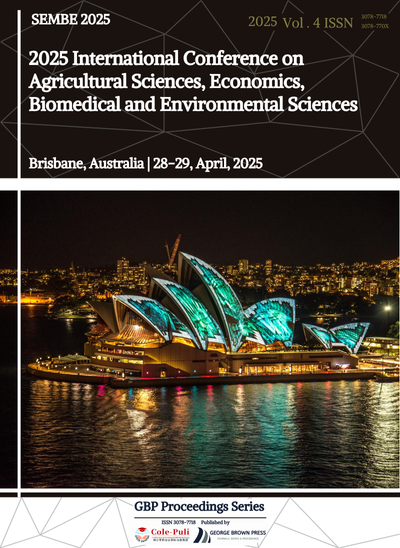Vegetative Response to Meteorological Factors in a Desert Oasis Area Based on Principal Component Analysis
DOI:
https://doi.org/10.71222/avqz6651Keywords:
deficit irrigation, water consumption patterns, yield and quality, water productivity, potatoAbstract
Based on the principal component analysis, we aimed to explore the mechanism for dynamics of oasis vegetation coverage on the basis of related meteorological factors. According to the six indicators including the annual precipitation, annual evaporation, average humidity, average wind speed, average temperature, and annual sunshine hour, two independent principal components such as annual evaporation and average temperature were extracted, with the cumulative variance contribution rate of 85.84%. The driving mechanism of meteorological drought in the whole desert oasis area was analyzed. The results showed that during the study period the annual evapotranspiration, average temperature, precipitation and humidity had greater influence on vegetation coverage dynamics than other two meteorological factors such as annual sunshine hours and wind speed. The partial correlation analysis indicated that the vegetative index was positively correlated with the average temperature (X5) and average humidity (X3) with the partial correlation coefficients and the correlation coefficient of 0.98, 0.977, and -0.901 respectively. However, the vegetative index was negatively correlated with the annual evaporation (X2) with the coefficient of -0.901. Therefore, the present work supplemented the effects of evaporation and humidity on the vegetative index, and we proposed that when the external drought weather conditions was not under control effectively, the manual intervention would still be the first choice to improve the vegetation coverage, which was to provide theoretical gists for vegetation growth and ecological restoration in desert oasis area.
References
1. H. H. Cui, G. H. Zhang, Q. Wang, M. J. Yan, L. Cao, and P. F. Liu, “Periodicity and mechanism of groundwater ecological function in natural oasis in the lower reaches of Shiyang River Basin,” Shuili Xuebao (J. Hydraul. Eng.), vol. 54, no. 2, pp. 199–219, 2023, doi: 10.13243/j.cnki.slxb.20220035.
2. F. Zhou et al., “Spatial-temporal variation characteristics and coupling coordination of the ‘water resources’,” Ecol. Indic., vol. 154, p. 110874, 2023, doi: 10.1016/j.ecolind.2023.110874.
3. F. R. Li, J. L. Liu, W. Ren, and L. L. Liu, “Land-use change alters patterns of soil biodiversity in arid lands of northwestern China,” Plant Soil, vol. 428, pp. 371–388, 2018, doi: 10.1007/s11104-018-3673-y.
4. S. Stefanidis, D. Rossiou, and N. Proutsos, “Drought severity and trends in a Mediterranean oak forest,” Hydrology, vol. 10, no. 8, p. 167, 2023, doi: 10.3390/hydrology10080167.
5. S. Lawal, B. Hewitson, T. S. Egbebiyi, and A. Adesuyi, “On the suitability of using vegetation indices to monitor the response of Africa's terrestrial ecoregions to drought,” Sci. Total Environ., vol. 792, p. 148282, 2021, doi: 10.1016/j.scitotenv.2021.148282.
6. H. Li et al., “Identifying conservation priority zones and their driving factors regarding regional ecosystem services,” Environ. Dev. Sustain., vol. 26, no. 8, pp. 20963–20985, 2024, doi: 10.1007/s10668-023-03514-4.
7. X. Jin, S. Wang, and W. Xia, “Response of vegetation to variation in climate and groundwater in the Qaidam Basin,” Hydrogeol. Eng. Geol., vol. 43, pp. 31–36, 2016, doi: 10.16030/j.cnki.issn.1000-3665.2016.02.05.
8. S. H. Mahmoud and T. Y. Gan, “Irrigation water management in arid regions of Middle East: Assessing spatio-temporal var-iation of actual evapotranspiration through remote sensing techniques and meteorological data,” Agric. Water Manag., vol. 212, pp. 35–47, 2019, doi: 10.1016/j.agwat.2018.08.040.
9. Z. Aslan, K. Natarajan, and M. Tankut, “Vegetation pattern of Istanbul from the Landsat data and the relationship with me-teorological parameters,” Ann. Geophys., vol. 12, no. 6, pp. 574–584, 1994, doi: 10.1007/s005850050084.
10. G. Yu et al., “Ecosystem health assessment based on analysis of a land use database,” Appl. Geogr., vol. 44, pp. 154–164, 2013, doi: 10.1016/j.apgeog.2013.07.010.
11. J. Chen, Y. Wang, F. Li, and Z. Liu, “Aquatic ecosystem health assessment of a typical sub-basin of the Liao River based on entropy weights and a fuzzy comprehensive evaluation method,” Sci. Rep., vol. 9, no. 1, p. 14045, 2019, doi: 10.1038/s41598-019-50499-0.











